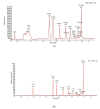Confirmatory Analysis of Per and Polyfluoroalkyl Substances in Milk and Infant Formula Using UHPLC-MS/MS
- PMID: 34208500
- PMCID: PMC8234569
- DOI: 10.3390/molecules26123664
Confirmatory Analysis of Per and Polyfluoroalkyl Substances in Milk and Infant Formula Using UHPLC-MS/MS
Abstract
An ultra-high performance liquid chromatography tandem mass spectrometry method was developed and validated for the sensitive determination and unambiguous confirmation of residues of per and polyfluorinated alkyl substances (PFAS) in breastmilk, retail milk and infant formulas following two sample preparation methods. Sample pre-treatment was carried out by a simplified QuEChERS method without requiring dSPE or any further clean-up. The method was validated in accordance with the requirements of Commission Decision 657/2002/EC with slight modifications. The method displayed good linearity with R2 ranging from 0.9843-0.9998 for all target PFAS. The recovery and within-laboratory reproducibility of the method (n = 63) were in the range 60-121% and 5-28%, respectively. The decision limit, detection capability and limit of quantitation ranged from 30-60 ng kg-1 to 40-100 ng kg-1 and 5-50 ng kg-1, respectively. Acceptable matrix effect values in the range -45-29% were obtained with uncertainty of measurement lower than 25% for all target PFAS. The method displays its suitability for the sensitive and high-throughput confirmatory analysis of C4-C14 PFAS in breastmilk, dairy milk and infant formulas.
Keywords: QuEChERS; UHPLC–MS/MS; breastmilk; confirmatory; infant formula; liquid–liquid extraction; retail milk.
Conflict of interest statement
The authors declare no conflict of interest.
Figures






References
-
- Wille K., Vanden Bussche J., Noppe H., De Wulf E., Van Caeter P., Janssen C.R., De Brabander H.F., Vanhaecke L. A validated analytical method for the determination of perfluorinated compounds in surface-, sea- and sewagewater using liquid chromatography coupled to time-of-flight mass spectrometry. J. Chromatogr. A. 2010;1217:6616–6622. doi: 10.1016/j.chroma.2010.03.054. - DOI - PubMed
-
- Tittlemier S.A., Pepper K., Seymour C., Moisey J., Bronson R., Cao X.L., Dabeka R.W. Dietary exposure of Canadians to perfluorinated carboxylates and perfluorooctane sulfonate via consumption of meat, fish, fast foods, and food items prepared in their packaging. J. Agric. Food Chem. 2007;55:3203–3210. doi: 10.1021/jf0634045. - DOI - PubMed
-
- Harrad S., De Wit C.A., Abdallah M.A.E., Bergh C., Björklund J.A., Covaci A., Darnerud P.O., De Boer J., Diamond M., Huber S., et al. Indoor contamination with hexabromocyclododecanes, polybrominated diphenyl ethers, and perfluoroalkyl compounds: An important exposure pathway for people? Environ. Sci. Technol. 2010;44:3221–3231. doi: 10.1021/es903476t. - DOI - PubMed
MeSH terms
Substances
LinkOut - more resources
Full Text Sources
Medical

